Happy International Women’s Day!
We all celebrate it, but are we all aware of its origins?
Here is a quick recap: International Women’s Day was born as a result of labour movements at the turn of the 20t century. The very first one was celebrated in Europe in 1910 (on March 19th then). Happening annually up to today, it serves as a moment to reflect upon the progress women have made in areas such as politics, economy, community, and everyday life. Its main aim is to act as a benchmark, per se, to pinpoint the development of women’s rights worldwide.
Now, since International Women’s Day is strictly tied to work, we have decided to celebrate it by releasing an article discussing the position of women on the job market. Even now, over 120 years after the celebration of the first International Women’s Day, we still hear about certain professions being “manly” or “not suitable for women”.
We have compiled some statistics and chatted with women who work or study in areas that, according to official statistics, are typically “male-dominated”. You may find the results surprising, so make sure to read till the very end!
1. Women in the workforce statistics
2. Women in "manly" professions
2.2. Criminology
2.3. Mathematics
2.4. Maritime Management
2.5. Leadership Roles
2.6. Chemistry
3. Why do women remain underrepresented in the workplace?
1. Women in the workforce statistics
To put things into perspective, we will present some facts regarding women in the workforce first.
What does it mean to be in the workforce? When someone is employed or actively looking for employment, we then say that they are participating in the workforce (also known as labour force). The infographic below presents some of the most interesting facts regarding the representatives of the fair sex in the labour market.
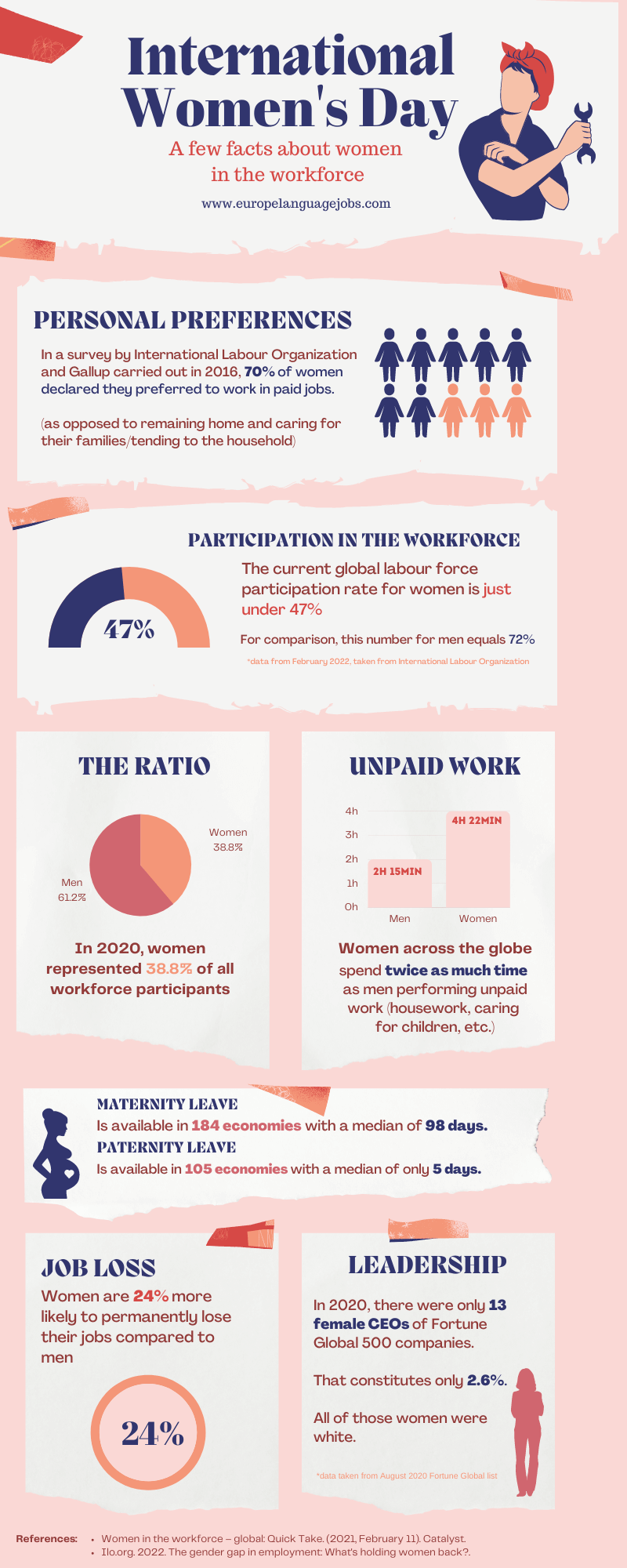
2. Women in “manly” professions
We have interviewed a few women from various European countries who study or work in areas that, according to statistics, are largely dominated by men. We have asked them to share their experience being a woman in a “manly” profession and have gained some very interesting insights from their accounts.
2.1. Dentistry and Medicine
Official statistics claim that the area of Medicine, in general, is still widely dominated by male employees. The only positions in the Medical sector where women are in a majority are Medical Practitioners or Nurses. Apparently, only 34.3% of dentists are female - a little over one-third of all representatives of this profession.
Here is what Marysia, a 3rd-year student of a Medical course specialising in Dentistry, said about the nature of her course:
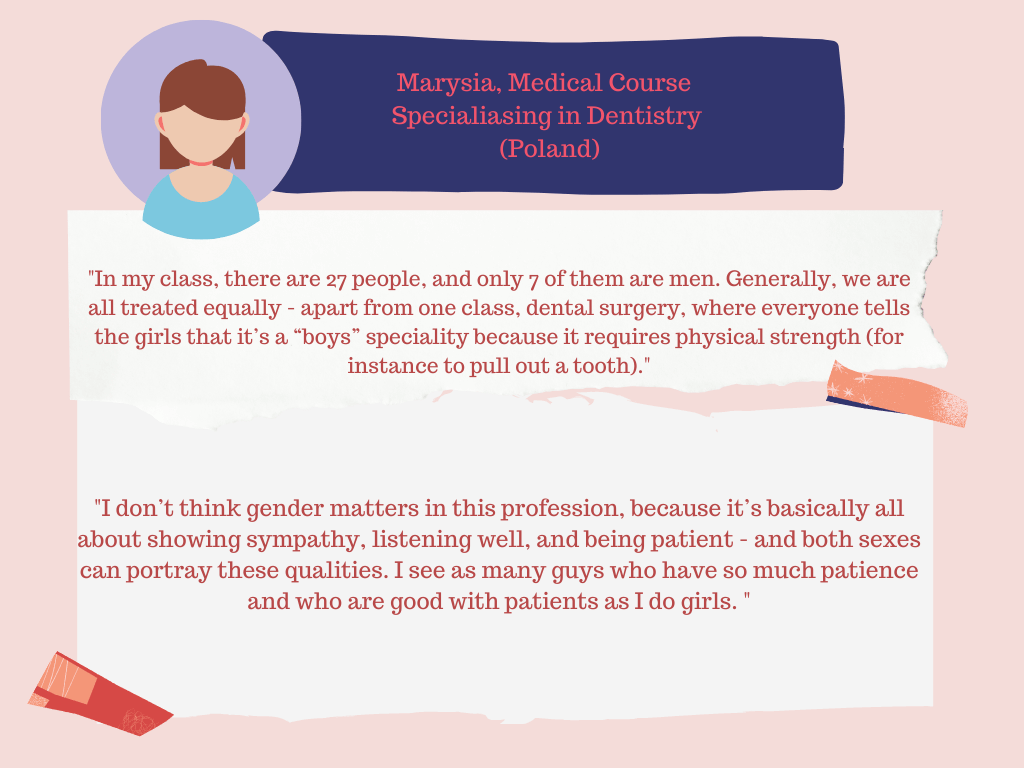
In Marysia’s experience, the young generation of people studying to be dentists is not driven by notions of gender stereotypes. The only act of favouritism towards the male gender in the form of advising female students against picking the dental surgery speciality due to lacking physical strength came from professors - not students.
This suggests that while some traces of prejudice and centuries-old stereotypes might still be still rooted in the older generation, young people are mostly choosing to stay free of them and make decisions according to their own instinct rather than what they are told by society.
2.2. Criminology
Megan is a Criminology and Sociology student, currently working on her Bachelor’s dissertation in her final year. Raised by a police officer, she has always wanted to take it a step further and become a detective. History shows that most crime investigators who have left their thumbprints on the pages of history were men.
Everyone who has seen Mindhunter - a series based on true persons and events - knows there is only one female character making an appearance in the FBI’s office. Pairing that with the statistics claiming that only 23.6% (this time less than one-fourth) of all detectives and criminal investigators are women, let’s see what Megan has to say about her experience so far:
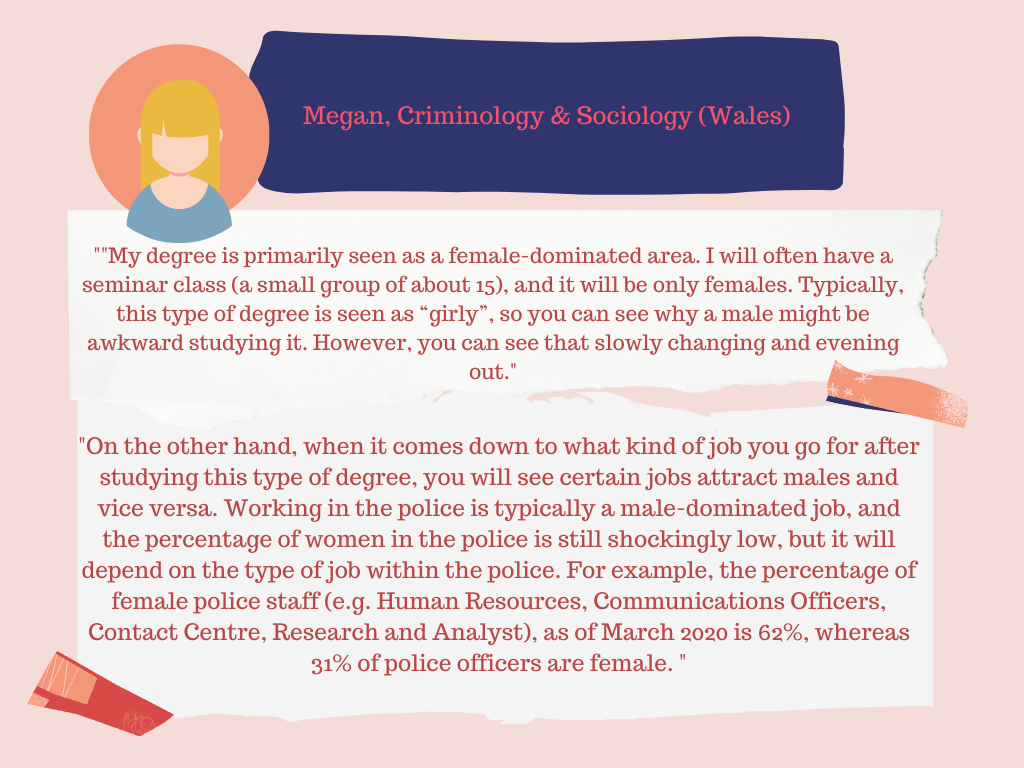
What we need to focus on in Megan’s account is the fact that things slowly keep changing. A majority of the most significant cases in the history of criminal investigation took place over the 70’s and 80’s - times much less advanced in terms of gender equality in the workplace than presently.
We have gone from collectively believing that only men can solve crimes to leaving that task primarily to women. We have somehow moved from one extremity to another, but let's focus on the positives. Progress has been made in terms of women solving crimes - the next step is a revolution regarding them fighting crime as police officers.
2.3. Mathematics
Naming one famous mathematician is probably hard enough for anyone who is not strictly interested in the subject. However, while many might eventually come up with a name, very few will most likely be able to answer the next question: Name one famous female mathematician.
As Mathematics and the author of this article do not get along - quite frankly, we are sworn enemies - we have talked to Aleksandra, who is currently in the middle of her 1st year of a degree in Mathematics. Statistics say that only 25.5% (a bit more than in the Criminology section but still not great) of computer and mathematical occupations are held by women. What does Aleksandra say?
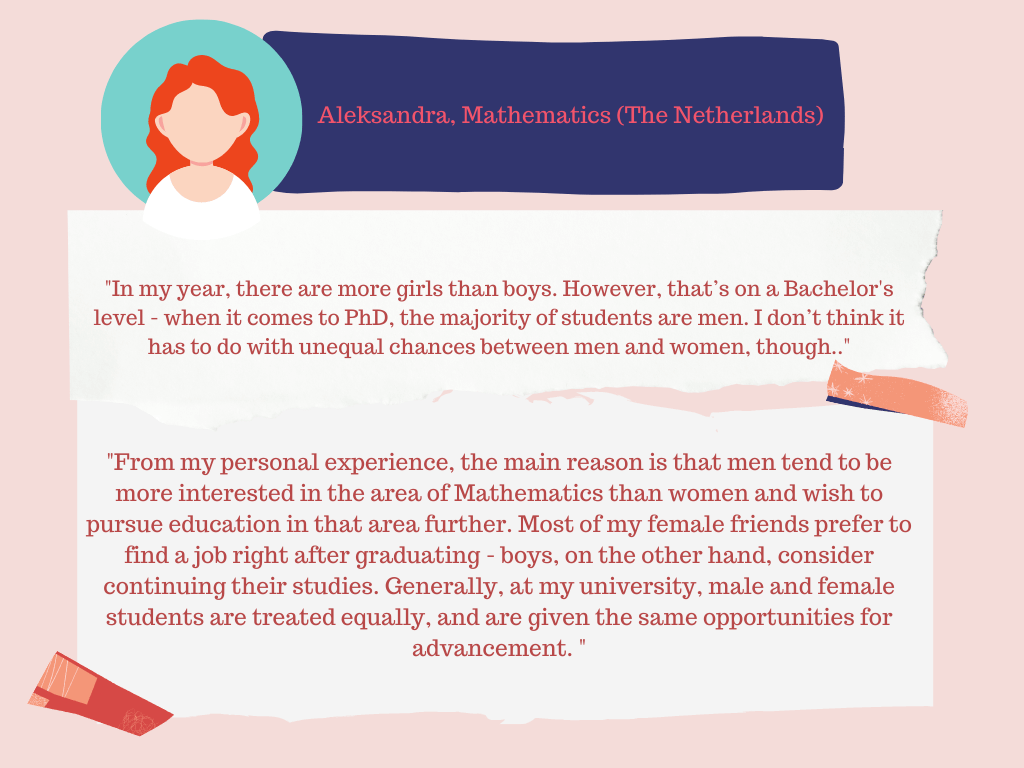
The statement that boys are interested in the sciences more often than girls might seem like a stereotype at first, but everyone I ask happens to really remember more male than female classmates favouring the STEM subjects at school. That is not to say women have lesser predispositions to pursue this career path - God forbid.
What is important is to make sure everyone has equal chances of pursuing their dream profession, regardless of their gender, sexual orientation, origin, political background, or any other factor that may lay grounds for discrimination. And, according to Aleksandra, that is the case, at least at her university in Amsterdam, which is something to be proud of.
2.4. Maritime Management
This rare but incredibly interesting area brings the most staggering data regarding the ratio of male and female employees on this list. Only 9.34% of all ship and hovercraft officers are women. That makes the second-lowest ratio so far - 23.6% in Criminology - not seem that bad, doesn’t it?
We had a chat with Daria, who has chosen to pursue this original career path and is making her way there by studying Maritime Management in Finland. She did point out that Captain Kate McCue, one of the most renowned modern female captains, has shared her experience of having her capabilities and authority questioned due to her gender on her social media accounts, but Daria’s personal observations are quite different:
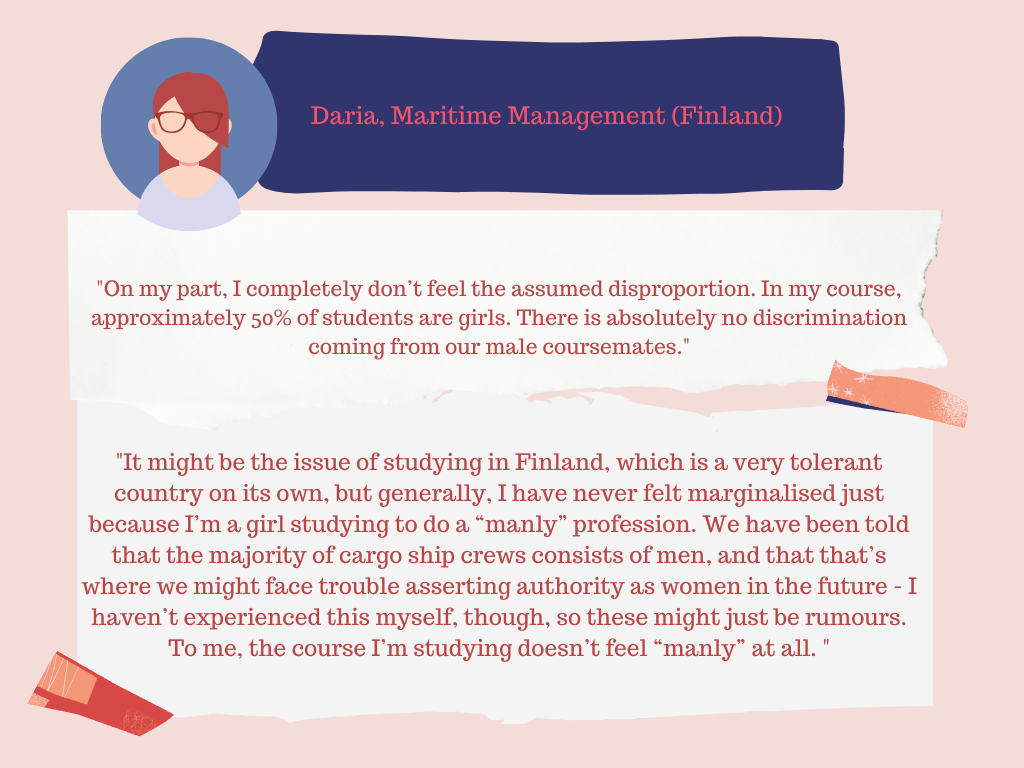
Perhaps it is once we leave the protection of university and enter into a real-life career when discrimination comes in. Or maybe, as we had pointed out while discussing the situation in the area of dentistry, it is the young generation currently studying to obtain their dream jobs that are less blinded by gender stereotypes than their older counterparts already working in the profession.
2.5. Leadership Roles
It is no secret that while women undeniably do hold the status of leaders, they are definitely harder to come by in executive positions than men. We are still waiting to see a female President of the United States, after all.
In 2020, Mercer carried out an analysis of over 1100 organisations worldwide regarding female leadership. These are the results:
-
Executives: 23%
-
Senior Managers: 29%
-
Managers: 37%
-
Professionals: 42%
-
Support Staff: 47%
We can clearly observe the numbers declining as we get closer to the very top. Following these sad statistics, we interviewed Aleksandra, who held the position of the President of Junior Enterprises Sønderborg for a year. These are her thoughts on the period of her cadency:
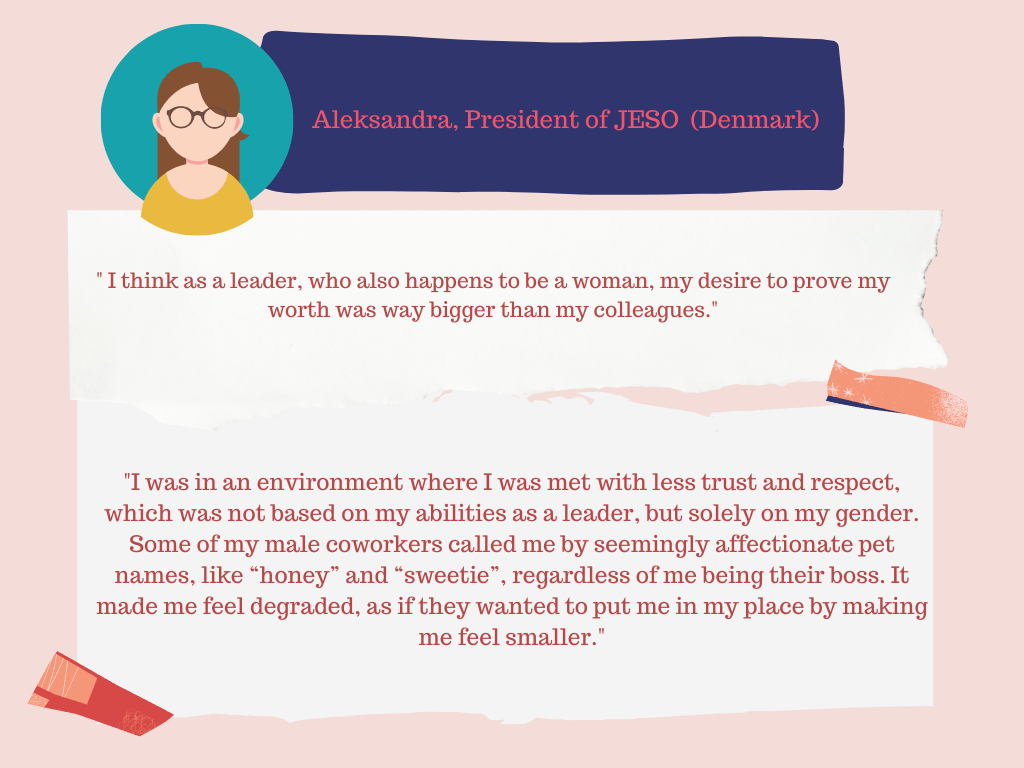
All of the previous accounts brought hope, proving that progress is definitely visible when it comes to the young generations’ approach to gender equality in the workplace. However, Aleksandra’s experience demonstrates that said progress, unfortunately, slows down the closer we get to leadership positions.
While we can say that we are finally reaching times when women are beginning to be treated as equals who can perform certain professions alongside men, not everyone’s minds are open enough yet to accept the idea of women holding a higher status. We might be warming to the idea of women being on the same level, but apparently not on a higher one.
2.6. Chemistry
Contrary to our riddle with famous female Mathematicians, we probably all know Marie SkÅ‚odowska-Curie. Still - at least according to numbers - she continues to be a pioneer in her domain. Nowadays, only 21.48% of all Chemical Scientists are women - without a doubt, a result much more satisfying than during Marie SkÅ‚odowska-Curie’s times, but still not entirely breathtaking.
Aleksandra is a 3rd-year student of Chemistry at Oxford Univesity. She shared with us some insights into the matters of gender equality in a theoretically “male-dominated” course at one of the most advanced universities in the world. So, what does the situation look like in the oldest university in the UK?

Not without a reason did we remind you that Oxford University is officially considered the oldest one in Great Britain. Founded before 1167, it wasn’t until 2017 that the school admitted more female than male students for the very first time (not just for the Chemistry course, but in general).
As they say, though, better late than never, and the faculty of Chemistry already welcomes as many girls as it does boys, so that is definitely something to celebrate! Especially that research shows that women constitute up to 35% of STEM students (STEM - Science, Technology, Engineering, Mathematics).
3. Why do women remain underrepresented in the workplace?
All of the accounts collected for the purpose of writing this article agree that the ratio between male and female students studying courses preparing for professions that are largely dominated by male workforce is more less even. This poses a question:
If the number of students of both genders is equal, why do women remain underrepresented in the workplace?
This might suggest that, despite the personal experiences described above, the notions of gender equality are pushed aside once we graduate and enter the competitive job market. The data illustrated in the infographics clearly shows that women continue to represent a small fraction of the workforce, and less than half of them are included in said workforce in the first place.
However, the situation of women in the workplace is much more complicated than that. Sometimes, it might not even be the issue of discrimination - the world is changing, but mothers still give up work with the aim of taking care of their families more often than fathers. And this is not necessarily because of stereotypes about gender roles - have a look at the statistics regarding maternity and paternity leave once again. More economies offer paid leave to mothers than fathers to begin with, and the average of 5 days off for fathers contrasts greatly with the 98 days off available for mothers.
We must keep working on opening our minds every day, but we also cannot limit certain problems to the lack of assertiveness in women or not enough initiative coming from men. Sometimes, it is the regulations that are to blame - and we all know those take much longer to change than individuals’ mentality.
On our part, we need to make sure that everything we do reflects the values we believe in. Women, brush off all claims that certain things are just not for you. Fight for what you want, work for it, and keep your head high. To make the world believe in you, you need to believe in yourself first.
Men, you do the same. Equality - despite what many think - is not about one gender towering over the other. True equality is about everyone of them being given the same chances, opportunities, conditions. Sometimes, women need to work just a little bit harder to achieve the same things, so support them in their quests - just like they will support you in yours.
What matters is that we don’t go to extremes - on either side of the spectrum. Mutual respect is key to healthy interpersonal relations, and respect can only be gained through understanding. We can reach that by spreading awareness, talking openly about it, abolishing taboos.
International Women’s Day is not just an excuse to receive flowers - it is an opportunity to do exactly those things listed above, to reflect upon the current situation, think about how we can improve it for the better, and take actual steps in that direction by acting.
The ELJ Team wishes you all a Happy International Women’s Day, and above all, we wish all of us that the next one in a year brings more progress - just like every single one after that.
All statistics presented in this article come from research conducted by Careersmart and Boston Globe.
Feeling inspired? Visit our blog for more career advice! How can you be sure the information we provide is top-notch? We are a group of professionals working with recruiters, career coaches, and HR specialists from all over the world!
Trust our experience and let us help you find a new job in Europe!










Paola Mora1y ago
Que importantes es hablar de estos temas pues a veces se nos olvida y es bueno que no lo recuerden.
Que importantes es hablar de estos temas pues a veces se nos olvida y es bueno que no lo recuerden.